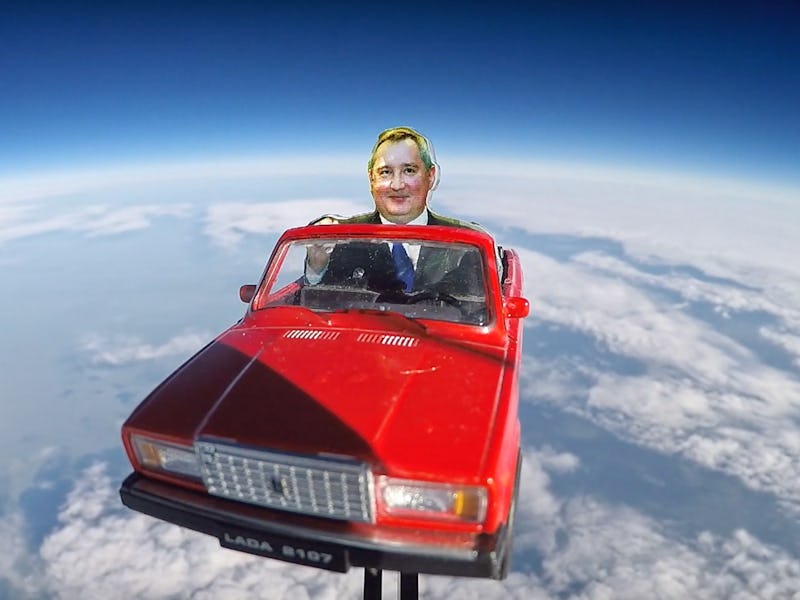SpaceX's ‘Starman’ Gets a Friend as Russia Launches Toy Car Into Space
The head of Roscosmos joined the Starman in the stratosphere.

Move over, SpaceX! A team of Russian scientists announced this week the successful launch of a red toy car into space, complete with a cutout resembling the head of the country’s space agency.
In a clear nod to the Falcon Heavy’s inaugural launch in February 2018, the team from the Tomsk State University in Siberia shared a YouTube video on Tuesday of their Zhiguli replica taking a trip to the stratosphere. A smiling picture of Dmitry Rogozin, director-general of Roscosmos, sat across the car’s driver and passenger seats in the front as an automatic stratosphere satellite whisked the contraption into space.
Similar to SpaceX’s groundbreaking flight, which saw the launch of the world’s most powerful operational rocket, the university’s ToSky project behind the launch also set new records. The Moscow Times reports that it’s the longest “stratosat” flight undertaken by any country of the former Soviet Union since 2013, with Rogozin’s red Zhiguli (known as the “Lada” outside of Russia) racking up an impressive 16 hours of airtime.
The flight, which took place on June 2, sent up the pair at a speed of 80 kilometers per hour (49 mph). They achieved a total height of 150 kilometers (93.2 miles), pushing past the Kármán line 62 miles above Earth that’s generally considered the starting point of space. The contraption landed 2,000 kilometers (1,243 miles) away from its start point, between Mongolia and China.
SpaceX’s ‘Starman’: The Launch That Started the Bizarre Trend
When SpaceX CEO Elon Musk said in March 2017 that he was going to send the “silliest thing we can imagine” on the Falcon Heavy’s maiden voyage, few probably expected him to send his own car into space.
The Falcon Heavy is a beefier version of the Falcon 9 rocket SpaceX uses to send satellites into space for commercial clients. Unlike the Falcon 9 that has a single core for sending 50,265 pounds to low-Earth orbit, the Falcon Heavy uses three cores to send up 140,660 pounds. With over five million pounds of thrust, it’s the most powerful rocket currently in operation. Only NASA’s Saturn V, which last flew in 1973, packs a more powerful punch.
Tesla "Starman"
The Heavy is designed for commercial clients like the Falcon 9, but Musk announced in December 2017 that the payload for the first test mission would be a midnight cherry Tesla Roadster with a dummy in the passenger seat wearing a SpaceX suit. The car was riddled with easter eggs: the sound system played David Bowie’s “Space Oddity” on loop, the dashboard had the motto “Don’t Panic” from Hitchhiker’s Guide to the Galaxy, and it also contained a “5D quartz laser storage device” with Isaac Asimov’s Foundation trilogy. The whole setup was launched in February 2018 on a journey to Mars.
“After that it’s just going to be out there in space for maybe millions or billions of years,” Musk said at the time. “Maybe discovered by some future alien race thinking what the heck, what were these guys doing? Did they worship this car? Why do they have a little car in the car? And that’ll really confuse them.”
SpaceX’s ‘Starman’: The Russian Rivalry Heats Up
The Roadster has been quietly continuing its orbit, currently moving toward Earth at a speed of nearly 14,000 mph. It is currently nearly 200 million miles from Earth. While the dummy’s been undertaking its bizarre journey, the rivalry between Musk and Roscosmos continued.
The agency was accused of a passive-aggressive reaction to the launch of SpaceX’s Crew Dragon spacecraft in March, which could mean that NASA no longer needs to send astronauts to the International Space Station using Russia’s Soyuz rockets. Space expert Vadim Lukashevich argued that SpaceX has made Roscosmos “null and void.”
It wasn’t the first time the two had shown signs of friction. Roscosmos failed to clear SpaceX for an International Space Station docking procedure in February, a decision reversed a few days later.
However, later in March, the agency congratulated Musk on the flight and Musk responded warmly:
With Musk showing interest in one day going into space himself and visiting his city on Mars, you can’t help but wonder if he feels a pang of jealousy knowing that replica Rogozin made it to space first.